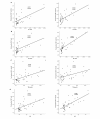Tim-3 expression on peripheral T cell subsets correlates with disease progression in hepatitis B infection
- PMID: 21392402
- PMCID: PMC3061941
- DOI: 10.1186/1743-422X-8-113
Tim-3 expression on peripheral T cell subsets correlates with disease progression in hepatitis B infection
Abstract
Background and objective: T-cell immunoglobulin domain and mucin domain-containing molecule-3 (Tim-3) represents a novel mechanism of T-cell dysfunction in chronic viral diseases. However, the role of Tim-3 in the pathogenesis of chronic hepatitis B (CHB) is not well understood. We investigated Tim-3 expression on peripheral T cell subsets and analyzed the relationship between Tim-3 expression and disease progression in HBV infection.
Methods: peripheral blood samples were obtained from CHB patients (n = 40), including 23 patients with moderate CHB [MCHB] and 17 with severe CHB [SCHB]. Control samples were obtained from nine acute hepatitis B patients (AHB) and 26 age-matched healthy subjects. The expression of Tim-3 on T cells was determined by flow cytometry.
Results: Tim-3 expression was elevated on peripheral CD4+ and CD8+ T cells from AHB and CHB patients compared to those from healthy controls. The percentage of Tim-3+ T cells was further increased in SCHB patients relative to MCHB patients and showed a positive correlation with conventional markers for liver injury (alanine aminotransferase (ALT), aspartate transaminase (AST), total bilirubin (TB) and international normalized ratio (INR) level). The frequency of Tim-3-expressing T cells was negatively correlated with T-bet mRNA expression and plasma interferon-gamma (INF-gamma) levels. Further, Tim-3 expression on CD4+ or CD8+ T cells was reduced in CHB patients with disease remission after antiviral treatment and in AHB patients during the convalescence phase.
Conclusions: Our results suggest that over-expression of Tim-3 is involved in disease progression of CHB and that Tim-3 may participate in skewing of Th1/Tc1 response, which contributes to persistency of HBV infection.
Figures





References
-
- Day CL, Kaufmann DE, Kiepiela P, Brown JA, Moodley ES, Reddy S, Mackey EW, Miller JD, Leslie AJ, DePierres C, Mncube Z, Duraiswamy J, Zhu B, Eichbaum Q, Altfeld M, Wherry EJ, Coovadia HM, Goulder PJ, Klenerman P, Ahmed R, Freeman GJ, Walker BD. PD-1 expression on HIV-specific T cells is associated with T-cell exhaustion and disease progression. Nature. 2006;443:350–4. doi: 10.1038/nature05115. - DOI - PubMed
Publication types
MeSH terms
Substances
LinkOut - more resources
Full Text Sources
Research Materials

